 There is nothing like an old friend stopping by to remind you of who you were.
There is nothing like an old friend stopping by to remind you of who you were.
It is certainly a cliché, but I was a different person in 1998. I was a gawky teen/band nerd that mostly assumed women were another, significantly alien species; and, more importantly, I had just let my Nintendo Power subscription lapse. It was a long, N64-based time coming, but, for the first time in my life, I was no longer “connected” to the gaming world. There would not be a monthly periodical arriving to inform me of all the grand games coming to my favorite console anymore, and, as a result, I was lost in the wilderness of Electronics Boutique during every visit. SaGa Frontier caught my eye for one simple reason: it was the same color as Final Fantasy 7. Overwhelmingly white CD case with some Amano-looking wispy dude wearing a patently ridiculous clothing/amulet combo? Sign me the hell up. Final Fantasy was a known quantity, Squaresoft was where Chrono Trigger originated, and a return to “sorcery” (an aspect of older Final Fantasy games that had been gradually given over to techno worlds at the time) was all that I needed. I had no idea what SaGa Frontier had in store for me, but I did have forty bucks of Summer spending I could spare for the experience.
And, yes, SaGa Frontier is certainly an experience.
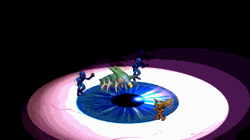 SaGa Frontier was directed and produced by Akitoshi Kawazu. And, while the SaGa franchise was familiar to fans in Japan, over here in America Town, Kawazu had only shown his hand in the Final Fantasy Legend series. And you only played that franchise if you had a Nintendo Gameboy and a really high tolerance for staring at a tiny, pea-green square’s worth of text (and a similarly high patience for banana smuggling). What’s more, the origins of practically everything involved in SaGa was introduced in Final Fantasy 2… a game that never saw release/a strategy guide in the West. And it is hard to describe just how different Kawazu directed games can be at times. Like, to attempt a terrible metaphor for the masses that might not have grown up farming cactuars on remote islands, it would be like… Hm… Imagine if Kawazu made cars. These Kawazu Cars would seem completely normal, but you could only use the brakes by licking the steering wheel in just the right way. Would plenty of people die thanks to this vehicle? Yes, obviously. It would lead to global catastrophes. But can you imagine the tongue-dexterity of those that survived? They would be able to lick-brake in amazing ways! And they would probably be better at parallel parking for some reason! Kawazu games will make you better at all games, because they encourage creative thinking and cultivating skills you might leave to languish elsewhere… but these games are also notoriously brutal in their learning curves. If you get it, you get it, but if you don’t, your protagonist is pudding.
SaGa Frontier was directed and produced by Akitoshi Kawazu. And, while the SaGa franchise was familiar to fans in Japan, over here in America Town, Kawazu had only shown his hand in the Final Fantasy Legend series. And you only played that franchise if you had a Nintendo Gameboy and a really high tolerance for staring at a tiny, pea-green square’s worth of text (and a similarly high patience for banana smuggling). What’s more, the origins of practically everything involved in SaGa was introduced in Final Fantasy 2… a game that never saw release/a strategy guide in the West. And it is hard to describe just how different Kawazu directed games can be at times. Like, to attempt a terrible metaphor for the masses that might not have grown up farming cactuars on remote islands, it would be like… Hm… Imagine if Kawazu made cars. These Kawazu Cars would seem completely normal, but you could only use the brakes by licking the steering wheel in just the right way. Would plenty of people die thanks to this vehicle? Yes, obviously. It would lead to global catastrophes. But can you imagine the tongue-dexterity of those that survived? They would be able to lick-brake in amazing ways! And they would probably be better at parallel parking for some reason! Kawazu games will make you better at all games, because they encourage creative thinking and cultivating skills you might leave to languish elsewhere… but these games are also notoriously brutal in their learning curves. If you get it, you get it, but if you don’t, your protagonist is pudding.
And, gentle reader, let me tell you that, in 1998, I was not ready for SaGa Frontier. I tried to approach the game as a traditional Squaresoft jaunt, and I was rewarded for my hubris with a number of dead heroes and heroines. What I projected would be a simple “mindlessly kill monsters, get stronger” experience required far more nuance than I ever anticipated. Robotically “grinding” in SF means the encounters get stronger, but your characters do not necessarily gain the new skills to meet these challenges. Actually succeeding means learning the abilities and aptitudes of your chosen warriors, training them in those specific areas, and then whipping out a Dream Super Combo after hours of hoping you chose the right martial artist for the job. It requires thinking, planning, comboing, and a full grasp of SaGa Frontier and its myriad of gameplay systems. And if you fail? Well, a collection of my own save files parked right before the final bosses, but with no possible path to victory seems to indicate that making the game “unwinnable” is a perfectly valid outcome for a SaGa title.
And, when I was 15, that seemed… reasonable? Like… maybe I deserved it?
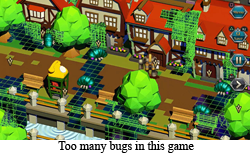 I mean, I did deserve it, right? I played the game wrong, and my punishment was an incomplete experience that could only be rectified by starting over. Memory card space was at a premium at the time, so it was not like I could simply reload from an earlier point where maybe I could have constructed a more useful party or learned a more useful skill. There are a thousand options in SaGa Frontier, and I chose the wrong options. And, in a way, this was not a big deal. SaGa Frontier was likely to be my “big JRPG purchase” to last me until Christmas, so I had time. This would be “my game” for the next few months, and if I had to restart, I would simply do that. Start all over armed with the knowledge I had sparked from an aborted playthrough and do better this time. Hell, the multiple characters/scenarios seemed to even encourage this: I failed with Emelia, and I could go back to her, but why not try Asellus this time? And, if I was really trying hard, I could hit the generally accurate advice of Gamefaqs, or shell out a few more precious dollars for a strategy guide. Now I was on the right track! I could handle seeing at least one aqua-colored sorcerer’s ending (or what passed for such). I might never see that all important dev room that required the full dedication of a player and memory card, but I could come close.
I mean, I did deserve it, right? I played the game wrong, and my punishment was an incomplete experience that could only be rectified by starting over. Memory card space was at a premium at the time, so it was not like I could simply reload from an earlier point where maybe I could have constructed a more useful party or learned a more useful skill. There are a thousand options in SaGa Frontier, and I chose the wrong options. And, in a way, this was not a big deal. SaGa Frontier was likely to be my “big JRPG purchase” to last me until Christmas, so I had time. This would be “my game” for the next few months, and if I had to restart, I would simply do that. Start all over armed with the knowledge I had sparked from an aborted playthrough and do better this time. Hell, the multiple characters/scenarios seemed to even encourage this: I failed with Emelia, and I could go back to her, but why not try Asellus this time? And, if I was really trying hard, I could hit the generally accurate advice of Gamefaqs, or shell out a few more precious dollars for a strategy guide. Now I was on the right track! I could handle seeing at least one aqua-colored sorcerer’s ending (or what passed for such). I might never see that all important dev room that required the full dedication of a player and memory card, but I could come close.
And now it is 2021. After 23 years, things are… different.
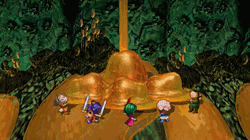 SaGa Frontier was once the only game I purchased within a whole season. Now, SaGa Frontier Remastered is one of many games I purchased within that same time period. Hell, it’s not the only game I purchased within one month. Double Hell, it’s not the only Square-Enix remaster of a game I already played that I purchased within a period of two weeks. By Blue’s Eternal Hell, I have some entertainment options now!
SaGa Frontier was once the only game I purchased within a whole season. Now, SaGa Frontier Remastered is one of many games I purchased within that same time period. Hell, it’s not the only game I purchased within one month. Double Hell, it’s not the only Square-Enix remaster of a game I already played that I purchased within a period of two weeks. By Blue’s Eternal Hell, I have some entertainment options now!
But that doesn’t do me as much good as my inordinately jealous 15-year-old self would believe. I have the income to purchase a game every seven seconds (and the Nintendo eShop alone produces new content apace), but, bad news, I have no time to actually play these games. Where once a game that touts seven or eight different scenarios that can take about ten hours each seemed like an unbelievable boon for the boy that could clear Donkey Kong Country before even opening his second Christmas present; now “you will lose 80-90 hours of your life” sounds like a goldarned threat. And it is “only” ten hours a scenario if you know what you’re doing. The idea that I could squeak through nine hours and then have to do it all over again because Hour Ten was too much? Preposterous! I could be playing every Mario game ever made right now, why would I ever bother with escorting some spoony bard to halfheartedly avenging his father? Dude can write a ballad about it, and I’ll listen to that. I do have three minutes to spare for a song sometime around next week…
And, while replaying SaGa Frontier does continue to give me the warm fuzzies, it also makes me think the game is a complete mess. SaGa Frontier offers new frontiers in freedom, and you can often go anywhere in its world, and visit areas that are made “for” a character that you are not using. And in any other JRPG with the premise of multiple playable characters/scenarios, you would arrive at an abandoned temple meant for Riki, but Red would say “there’s no reason we have to be here” and walk away. Or there would be a permanent “guard” outside. Or you wouldn’t even be able to select the area on the map. Or something. SaGa Frontier gives you the autonomy to say “hey, you want to explore here? Go ahead!” And that was sorely lacking from other JRPGs in its day! And our today, too! How many people would get excited yesterday or today by trying to squeeze one character into a place they “shouldn’t be” just to see what would happen? (“Hey, I got Gogo to work in the World of Balance!”) But, that said, the answer here is sad, because you can bring T260G to somewhere she is not supposed to go… and the best you see out of it is maybe some decent treasure. But more likely it is just a literal waste of time. A throne room with no king, or a secret passage leading to no secret. You went to the wrong ruins, buddy. And did that feel worth it for you? Maybe! But more often than not, when an area doesn’t have a distinct reward, it feels like you did something incorrectly. It varies from player to player, but it is very easy to do a lot in SaGa Frontier, and feel like the end result of those adventures is a whole lotta nuttin’. And exploring an area meant for Riki during Emelia’s campaign, finding nothing, and then revisiting it for the “real” scenario with Riki feels less like “I got this” and more like “Oh, heck, now I have to fight this stupid squid again”.
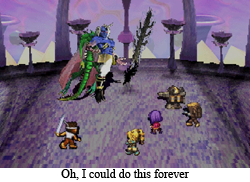 When there is the possibility that you can explore 90% of the whole game with one scenario, there is the distinct danger that the player is going to become too exhausted/frustrated trying to play 630% of the game. And never mind “knowing” that, like, one goofy NPC or dungeon is going to be a silly diversion in six scenarios, but absolutely essential in scenario seven…
When there is the possibility that you can explore 90% of the whole game with one scenario, there is the distinct danger that the player is going to become too exhausted/frustrated trying to play 630% of the game. And never mind “knowing” that, like, one goofy NPC or dungeon is going to be a silly diversion in six scenarios, but absolutely essential in scenario seven…
Which brings me to a conclusion that my 15-year-old self never would have even considered: SaGa Frontier was a little too understood by its authors. There are a lot of design decisions that can absolutely make sense in SaGa Frontier, but only if you really appreciate the whole of the game. You must understand every scenario, every sidequest, and the importance of knowing the difference between the two before you burn out on experiencing everything. Or that, narratively, the fact that, say, Blue is very much just a jerk, and isn’t like another PSX Final Fantasy-esque “he’ll be less gruff eventually” protagonist is super important to his ultimate fate, but you really can’t understand the full scope of that until you realize Blue’s counterpart, Rogue, was “the good twin” all along thanks to encounters in other scenarios. And the whole of the game (once again: thanks memory cards) is not the easiest thing to grasp under the best of circumstances. A lot of these decisions make sense in the fullness of understanding all of SaGa Frontier, but in the individual moments of it, it is all over the place, and likely to “offend” a player with its very distinct choices.
And Time Lord knows it offends this modern-day Goggle Bob.
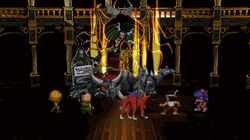 SaGa Frontier is a good game. SaGa Frontier Remastered is a good game made even better. But playing the two games at two very different points in my life has reminded me how much things have changed over the last few decades. A game that was once “difficult” can now be safely judged as “difficult to understand”. And, while this does not detract from the experience, it may impress upon this player that, at an age when time is valuable, maybe learning the ins and outs of an extremely unique JRPG is not the best use of the day.
SaGa Frontier is a good game. SaGa Frontier Remastered is a good game made even better. But playing the two games at two very different points in my life has reminded me how much things have changed over the last few decades. A game that was once “difficult” can now be safely judged as “difficult to understand”. And, while this does not detract from the experience, it may impress upon this player that, at an age when time is valuable, maybe learning the ins and outs of an extremely unique JRPG is not the best use of the day.
SaGa Frontier, it’s not you, it’s me. I’ve changed. And you’re better, but still too the same.
FGC #599.1 SaGa Frontier (Remastered)
- System: Playstation 1 for the original, Playstation 4, Nintendo Switch, and various contemporary computer platforms for the modern player. Was it ever a PSN release? It could have worked on the Vita…
- Number of Players: Fuse makes for our eighth playable character in the remaster, but you still can only control one at a time.
- I’m not racist, but: I do not care for monsters. A lot of effort for very little return. Though I do appreciate how lummox and skeleton king alike can turn into a slime pile thanks to a bad chunk of monster meat.
- Make your choice: Choosing Rune Magic means you will go to prison. Arcane Magic means you will get tipsy as hell and drunkenly stumble through a jungle of deadly, sober monsters. I know my choice.
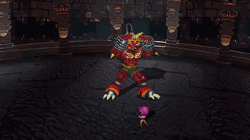 So are you still just super bitter about being locked out of the Emelia “good ending” because you decided to follow a lead when you should have just immediately given up? No, of course not. That would be silly. That is totally not the reason I harbor resentment against the entire SaGa franchise. I don’t know why you would ever think such a thing.
So are you still just super bitter about being locked out of the Emelia “good ending” because you decided to follow a lead when you should have just immediately given up? No, of course not. That would be silly. That is totally not the reason I harbor resentment against the entire SaGa franchise. I don’t know why you would ever think such a thing.- Reading is fundamental: Yes, I still have the strategy guide from the late 90’s. Yes, it is still useful for about 90% of the game, as full-color maps and a bestiary are always valuable. And, hey, it is generally nice to be reminded of which characters can recruit which other characters. Did you know Emelia hates robots? I think it comes up somewhere…
- The times change: I remember finding Red’s scenario as a mock Power Ranger so exciting and unique back when I first played SaGa Frontier. Now I am tired of sentai sendups, and SF’s version of the trope isn’t even all that interesting (is M Black supposed to be sympathetic because of, like, two bits of dialogue? Really?). Move along, Red, Viewtiful Joe has taken your place in my heart.
- Did you know? There are three characters in SaGa Frontier named “Red”. Red is a main character that fights against Black X. Rouge (French for Red) is the twin rival of Blue the Magician. Red Turnip is a turnip with a poor sense of direction. Find some new colors, SaGa!
- Would I play again: Funny you should ask that…
What’s next? We’re not done with SaGa Frontier just yet. Come back on Friday for a deep dive on my favorite SaGa Frontier story. Please look forward to it!
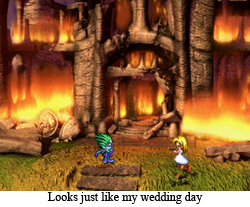

I said as much over in Talking Time’s thread for the game, but I love how much that the game world is NOT designed specifically for the convenience of the player character living within it.
Koorong is your big hub world with all manners of goods to buy but instead of the typical Weapon/Armor/Item shops you have individual dedicated stores for headwear, footwear, army surplus wear (your body armors and gloves), medicinal curatives (i.e. NOT REPAIR KITS), and a leather buyer out in the open with a gold buyer and an inn amongst the establishments you can go into. If you want blades or guns, climb down the nearby manhole out of sight and talk to one of the robots. If you dig really deep into the back alleys and sewers you may find the heavy weapons store with the good stuff.
And this kind of design focus is game-wide! Manhattan has a shopping mall, but literally the only place of interest (outside of the odd character-specific quests) in that sky city is the lone jewelry shop. Devin is a tourist trap with way more fortune-telling scams than legitimate magic stores. Outside of the beautiful scenery, the only things Kyo has to offer to visitors are Mind magic and souvenirs.
And Yorkland…Yorkland…Unless your quest takes you there or you’re looking to recruit Lute’s bro and/or drunkenly stumble through the horrible Kraken-infested swamp looking for the Grail card (or grind Krakens once you got water resistance), there’s no reason to go there. It’s just a rural town where people live their lives and brew alcohol for export to more interesting places. Booze won’t help you in your (overall) quest and Lute’s mom doesn’t like random strangers busting into her home unannounced.
Other little flourishes like not just being able to sell stuff to anyone you want (You have to find a dedicated buyer (like the leather shop) and they’ll only ever accept a few specific items) and most of the locations on the first page of Koorong’s locale list being accessible from one another by ship ‘cuz they’re presumably close to one another* also help contribute to making SaGa Frontier’s mixing pot of genres feel a li’l more like a real world. The game does a lot with a little.
Also I’m impressed that the game has its own dedicated casino world but unlike every other jRPG ever it completely resisted the temptation of throwing in a pile of gambling mini games.
* Yorkland’s the lone exception to this, it can be accessed from the others but its ship only goes back to Koorong.
[…] 2 had an innovative plot about intrigue and comradery, and a “leveling system” that launched an entire franchise unto itself. But it did not have any decent dungeons. Give or take including a “monster closet”, this […]
[…] Original Stream Night: May 18, 2021 Night of the Frontier of Sagas […]
[…] Good day and welcome to a Goggle Bob and Jeanie stream. We’re kicking things off by complaining about SaGa Frontier. […]
[…] all year, with tracks from Nier, Xenogears, Mana, and Chrono Trigger/Cross all making the roster. SaGa titles are also available for those masochists in the audience. Final Fantasy 16 did eventually arrive […]